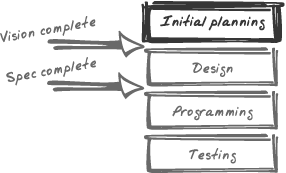Chapter Four. Writing the good vision

One challenge in leading teams is keeping people focused on the same goals for long periods of time. All leaders fear that decisions they make won't be remembered. It's possible that the reasons people had for listening to them today will be forgotten or ignored tomorrow. Perhaps worse, managers themselves may forget which direction they are supposed to be leading the project in. So, the challenge of project management is not only to get things started in the right direction, but also to keep it headed that way.
Chapter 3 included a brief overview of planning documents, such as MRD, vision, and specification. This chapter will focus in on the vision document, the most important of all early planning materials. I'll explain why vision documents are worth the effort to write, what qualities good ones have, and how to continually get value from them over the course of a project. When they are used properly, they conclude the initial planning phase of a project (see Figure 4-1).
Figure 4-1. A finalized vision document signifies the end of the planning phase, just as final specifications signify the end of the design phase.

But one note before I start. There are many different ways to divide the ground that MRDs, visions, and specifications cover. ...
Get The Art of Project Management now with the O’Reilly learning platform.
O’Reilly members experience books, live events, courses curated by job role, and more from O’Reilly and nearly 200 top publishers.

